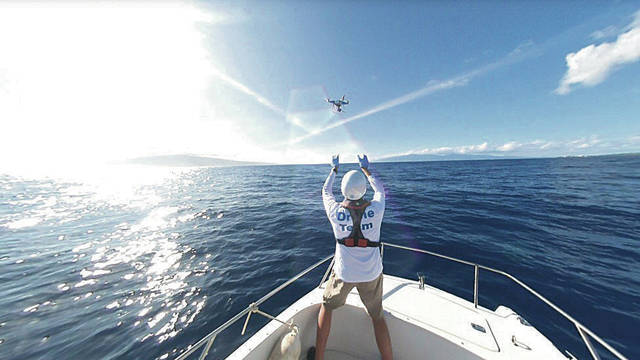Whales entangled in debris in Hawaii get help from team of drones


COURTESY OCEANS UNMANNED
NOAA is partnering with a California-based nonprofit called Oceans Unmanned to use drone technology to help disentangle humpback whales near Maui.


Federal rescue teams in Hawaii are now using small DJI drones to help free humpback whales caught in tangles of debris.
The National Oceanic and Atmospheric Administration Hawaiian Islands Humpback Whale National Marine Sanctuary Opens in a new tab has partnered with Oceans Unmanned Opens in a new tab of California to use drone technology to assist with whale entanglement response efforts off of Maui.
Oceans Unmanned, a nonprofit founded by former NOAA sanctuary manager Matt Pickett in California, released a video Wednesday offering more details on the program.
Aerial imagery from the drones provide details on the entangled whales that improves responders’ situational awareness as they proceed.
Specialists from NOAA have worked for decades with local volunteers, using knives on long poles to cut whales free.
Cutting loose a 45-foot, 40-ton, free-swimming animal is no easy task and can be dangerous, according to Ed Lyman, NOAA large whale entanglement response coordinator.
Don't miss out on what's happening!
Stay in touch with breaking news, as it happens, conveniently in your email inbox. It's FREE!
Approaching within less than 100 yards from a whale may only be attempted by persons authorized under permit by the NOAA Fisheries Marine Mammal Health and Stranding Response Program, he added.
“When you get close to a whale that size, you are moving into a danger zone,” said Lyman, who has been disentangling whales for 25 years, in the video. “So what we are doing is, the drone gives us the assessment, tells us what we need, and then when we do make an approach, we’re making it to cut the animal free — very efficient and a very good tool to have in a toolbox.”
He said having it makes the procedure safer.
With its recently launched freeFLY program, Oceans Unmanned is providing equipment — Phantom 4 Pro systems and accessories donated by DJI — and management oversight, plus training a network of Maui-based volunteer drone operators to support whale disentanglement efforts while meeting NOAA permit requirements. The volunteers learn to operate on a small boat, which is more challenging than operating drones from land.
Three Maui volunteer operators were certified in a recent training class. Additional training is scheduled in the fall.
“In the past, we had to get close to the whales at least three times,” said Pickett. “Once to figure out where the animal was entangled, once to cut them free and once to make sure the job was done right and nothing was left behind.”
With drones, the team can cut the process down to one step. Using small, remote-controlled quadcopters with powerful cameras, the team can do an initial assessment and final check.
“It makes the entire process much safer for both the humans and the whales,” said Pickett.
DJI is donating Phantom 4 Pros to the program, while DARTdrones is providing online “Part 107 Remote Pilot Certificate” Opens in a new tab test preparation classes for candidates to become compliant with Federal Aviation Administration requirements.
Each year, numerous whales and other marine animals are entangled in fishing gear, according to NOAA. The debris can hurt or kill whales and other animals that lack opposable thumbs to free themselves, resulting in starvation, strangulation and drowning.
Over 30 years, Lyman said an estimated 1,300 humpback whales have been disentangled through NOAA’s efforts.



